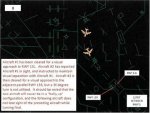Background Information
 “In the above example, the phrase ‘follow’ could be used in lieu of ‘maintain visual separation.’”
“In the above example, the phrase ‘follow’ could be used in lieu of ‘maintain visual separation.’”
This is incorrect, as detailed in the response to the first question in this interpretation. The use of “follow” in-lieu of “maintain visual separation” is not permitted.
Question
Since paragraph 7-4-3 c.2. does not specify that the aircraft are required to be going to the same runway, is it a valid clearance to instruct the following aircraft to follow the preceding aircraft, but clear the aircraft for a visual approach to an adjacent parallel runway, if the runways that each aircraft are cleared to are appropriately stated and acknowledged?
Reply
No. It is not a valid clearance to instruct an aircraft to follow a preceding arrival if it is not cleared for an approach to the same runway.
The word “follow” in conjunction with a visual approach clearance is an application of pilot- applied visual separation. However, it is intended to be used only when an aircraft is landing on the same runway as the arrival that it has been instructed to follow. If a pilot is cleared for a visual approach and instructed to follow an aircraft that is on an approach to a different runway, this could lead to a misunderstanding of the runway assignment. With growing concerns over Wrong-Surface Landings, control instructions must be clear and specific to reduce the chance for pilot error.
Question
Paragraph 7-4-4, c.1 clearly permits the use of visual separation between aircraft proceeding to the adjacent runway by requiring the succeeding aircraft to report the preceding aircraft in sight on the adjacent final approach course. Is it valid then that, when visual separation is established as described above, there is no requirement for the succeeding aircraft to intercept the extended centerline of the runway at an angle not greater than 30 degrees?
Reply
Yes, it is valid. There is no requirement in subparagraph 7-4-4 c.1 to use a 30-degree intercept angle with a succeeding aircraft.
Question
Paragraph 7-4-4 c.2(a) uses the phrase ‘approved separation is provided until the aircraft are.’ Does approved separation in this paragraph include the use of visual separation?
Reply
No. References to “approved separation” do not include visual separation. Although visual separation can be employed by ATC under certain conditions, it does not meet the definition of “approved separation”, which can be found in FAA JO Order 7110.65, subparagraph
1−2−1. WORD MEANINGS.
Question
If approved separation does include visual separation, is it valid to use the same type of separation in this instance as described in 7-4-4c.1? It would appear that if a 30 degree intercept is not required in instances where visual separation is applied and the RWY's are separated by less than 2,500 feet, it would not be required if visual separation is used when the RWY's are separated by at least 2,500 feet, but less than 4,300 feet.
Reply
No. As stated above, visual separation does not fall under the definition of “approved separation”. Additionally, the separation requirements of subparagraph 7-4-4 c.1., which has no requirement for a 30-degree intercept, cannot be applied to airport configurations with parallel runways separated by more than 2,500 feet.
Subparagraph 7-4-4 c.2 allows for simultaneous, independent operations. Compliance with this requirement reduces the potential for overshoots of the extended centerline of the runway of intended landing and potentially creating a hazard to an aircraft on the adjacent final approach course.
Question
NOTE #1, after 7-4-4 c.2(a)(3), states that the intent of the 30 degree intercept angle is to reduce the potential for overshoots of the extended centerline of the runway and preclude side-by-side operations with one or both aircraft in a ‘belly-up’ configuration during the turn. If vertical, lateral or visual separation is applied and the aircraft are never going to be in a ‘belly-up’ configuration, is the 30-degree intercept required? This is most apparent when the two aircraft are approaching the final approach course from the same direction, and the following aircraft does not lose sight of the preceding aircraft while turning final.
Reply
No. The 30 degree intercept is not required if there will not be a “belly-up” configuration with parallel traffic and if there is no potential for an overshoot that will conflict with traffic on the parallel approach.
Subparagraph 7-4-4 c.2 does not apply to the scenario in
D10’s depiction B (below). Aircraft #2 could not be in a “belly-up” configuration with Aircraft #1, nor would an overshoot of the RWY 13R extended centerline conflict with any parallel runway traffic. However, it is important to note that if the scenario were reversed, with Aircraft #1 landing on the farther runway (RWY 13R) and the second turning to the closer parallel runway (RWY 13L), a 30-degree intercept would be required to prevent a “belly-up” arrangement and potential overshoot.
